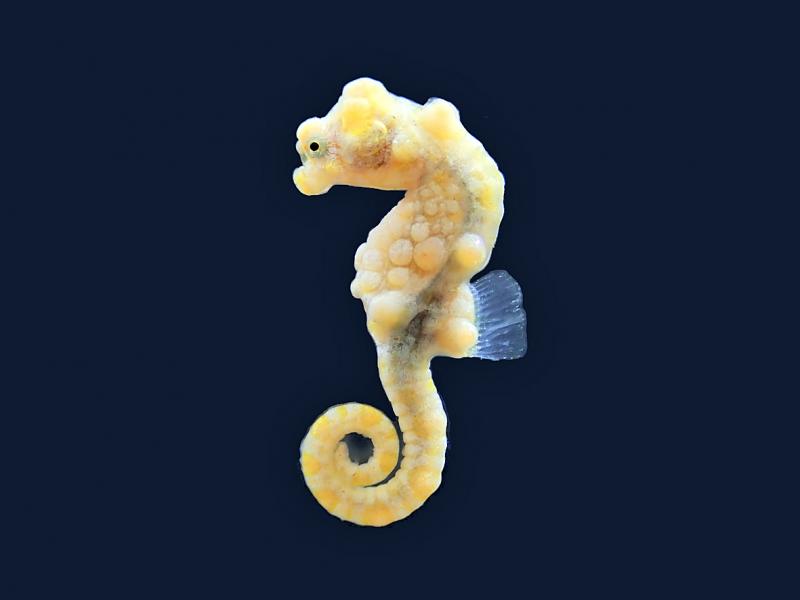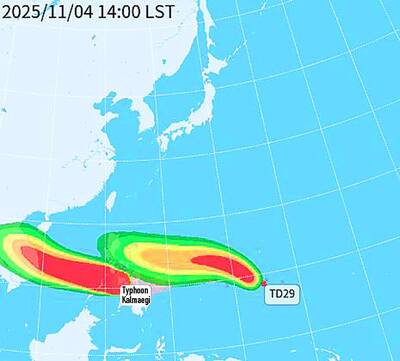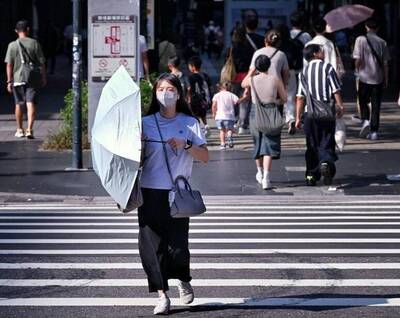A National Academy of Marine Research (NAMR) team last month found a species of pygmy seahorse for the first time near islands in Penghu County, the institute said yesterday.
The pygmy seahorse, known as Hippocampus bargibanti, was discovered 30 nautical miles (55.6km) southwest of Cimei (七美), the southernmost island in the Penghu archipelago, during a research trip, the academy said.
It is the first time the species — which is beloved by coral reef photographers for its “adorable” appearance — has been found in the area, it added.

Photo courtesy of the National Academy of Marine Research
The discovery indicates that the area of the Taiwan Strait where the species was spotted is suitable as a natural habitat for the pygmy seahorse, NAMR president Chiu Yung-fang (邱永芳) said.
The institute would continue its work to develop a better understanding of the area, which marine researchers did not begin to explore until last year due to strong currents and complex ocean floor terrain, she said.
During the trip, researchers used a small dredge net to collect samples from the seafloor, the institute said, adding that this is a common method of collecting samples from benthic zones.
Among the samples collected, the researchers found a pygmy seahorse, which was already dead, it said, adding that the animal would be used as a research specimen.
Pygmy seahorses have previously been found around Taiwan. According to the Fish Database of Taiwan, which is managed by Academia Sinica, the species was first discovered in Taiwanese waters in 2007, near Green Island (綠島).
Since then, pygmy seahorses have been spotted by recreational divers off northeastern, southeastern and southwestern Taiwan.
The pygmy seahorse is a tiny sea creature that measures less than 2cm in length, has a pinkish or yellowish body and usually attaches itself to vibrant corals, where it feeds on plankton.

Three Taiwanese airlines have prohibited passengers from packing Bluetooth earbuds and their charger cases in checked luggage. EVA Air and Uni Air said that Bluetooth earbuds and charger cases are categorized as portable electronic devices, which should be switched off if they are placed in checked luggage based on international aviation safety regulations. They must not be in standby or sleep mode. However, as charging would continue when earbuds are placed in the charger cases, which would contravene international aviation regulations, their cases must be carried as hand luggage, they said. Tigerair Taiwan said that earbud charger cases are equipped

Foreign travelers entering Taiwan on a short layover via Taiwan Taoyuan International Airport are receiving NT$600 gift vouchers from yesterday, the Tourism Administration said, adding that it hopes the incentive would boost tourism consumption at the airport. The program, which allows travelers holding non-Taiwan passports who enter the country during a layover of up to 24 hours to claim a voucher, aims to promote attractions at the airport, the agency said in a statement on Friday. To participate, travelers must sign up on the campaign Web site, the agency said. They can then present their passport and boarding pass for their connecting international

WEATHER Typhoon forming: CWA A tropical depression is expected to form into a typhoon as early as today, the Central Weather Administration (CWA) said yesterday, adding that the storm’s path remains uncertain. Before the weekend, it would move toward the Philippines, the agency said. Some time around Monday next week, it might reach a turning point, either veering north toward waters east of Taiwan or continuing westward across the Philippines, the CWA said. Meanwhile, the eye of Typhoon Kalmaegi was 1,310km south-southeast of Oluanpi (鵝鑾鼻), Taiwan’s southernmost point, as of 2am yesterday, it said. The storm is forecast to move through central

Taiwan sweltered through its hottest October on record, the Central Weather Administration (CWA) said yesterday, the latest in a string of global temperature records. The main island endured its highest average temperature since 1950, CWA forecaster Liu Pei-teng said. Temperatures the world over have soared in recent years as human-induced climate change contributes to ever more erratic weather patterns. Taiwan’s average temperature was 27.381°C as of Thursday, Liu said. Liu said the average could slip 0.1°C by the end of yesterday, but it would still be higher than the previous record of 27.009°C in 2016. "The temperature only started lowering around Oct. 18 or 19